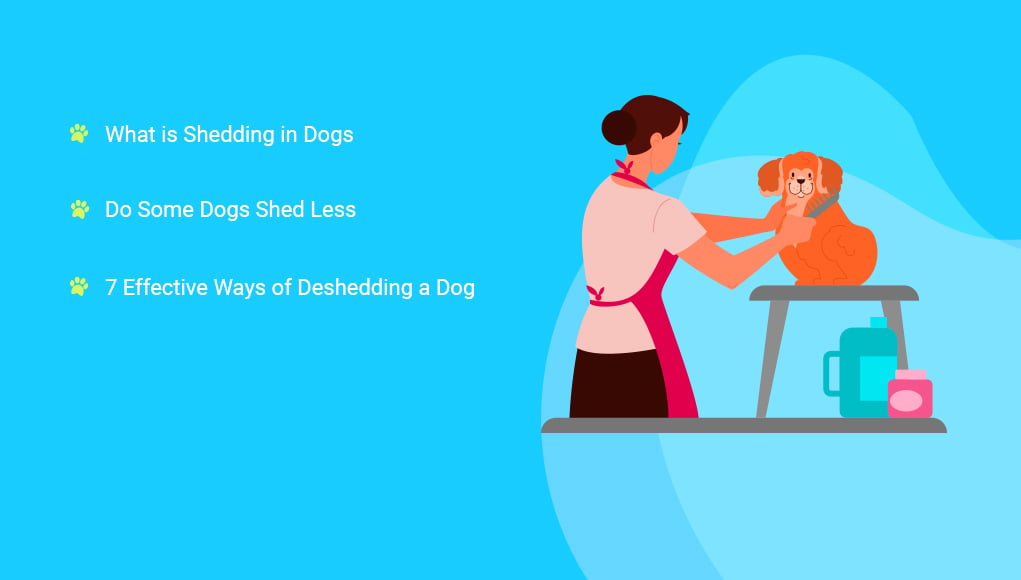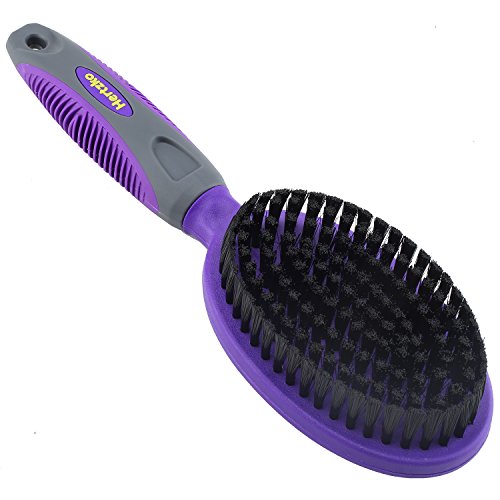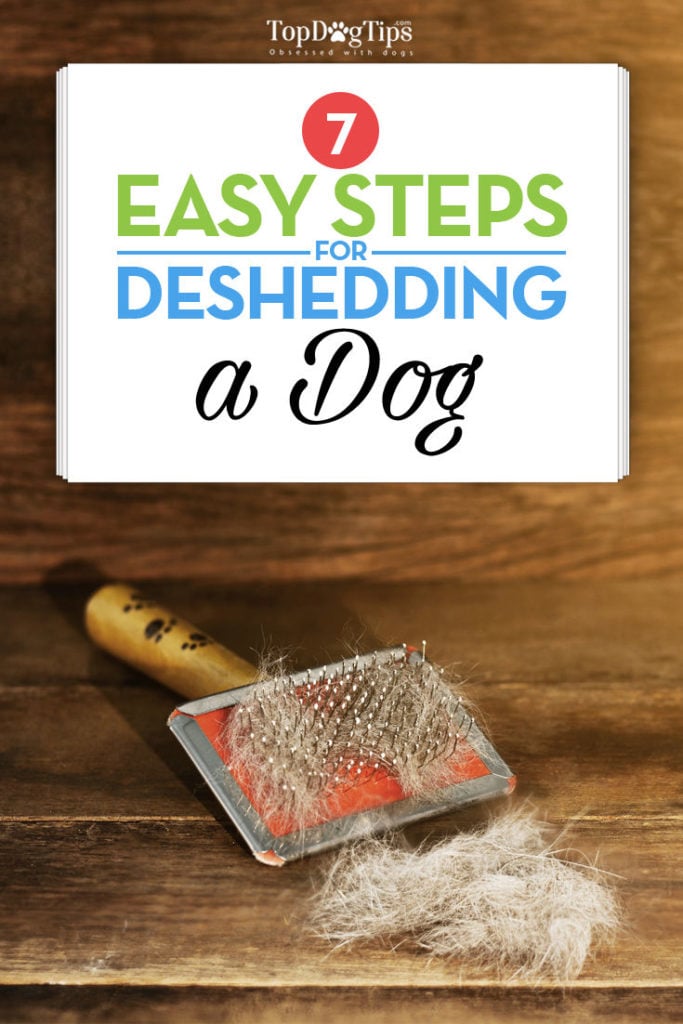It may be a little embarrassing when guests leave your home all covered in dog hair. And you'll find most of it all over the furniture.
For the dog, too, shedding can be itchy, uncomfortable, and sometimes even cause skin complications.
Deshedding a dog, is a necessary part of the dog grooming process and highly recommended.
Table of Contents
What is Shedding in Dogs?
All dogs shed to some degree.
It’s a natural process that allows the new coat to come in. Some breeds shed all year round; others have a seasonal shed. Some breeds with slow-growing hair shed less.
Knowing how to de-shed a dog will help you deal with the insurmountable amount of pet hair your dog may be leaving around the house.
Shedding in dogs is the removal of a dog's loose undercoat hair.
When you de-shed your pet, you're ridding him of loose dog hair that will eventually end up on your furniture and clothes.
Doing this benefits your dog by making him more comfortable and keeping the dog's coat and skin healthy and clean.
Moreover, regularly de-shedding a dog allows you to monitor how much hair is leaving the dog's body.
This is important because excessive shedding can be a sign of certain diseases in dogs.
In fact, the constant scratching and excessive shedding in dogs is a sign for you to book an appointment with a veterinarian.
Do Some Dogs Shed Less?
It's a biological fact that a dog must shed hair – there's no way around it. However, some breeds do, in fact, shed less.
Even though there are no completely shed-free dogs out there (it's a myth), certain breeds may be more acceptable for anybody worried about pet hair.
The breed will influence how much your dog is going to shed.
One of the largest dog genetic studies published in the Nature science journal has confirmed that the sole reason for how much a dog will shed is determined by its genes, influencing a dog's fur length and body size.
Besides picking a breed that sheds less, there are also ways you can reduce or prevent shedding in your dog.
Certain tools are effective with dogs that shed either a little or a lot and leave their hair all over your clothes and furniture. Deshedding tools are specifically designed for this purpose, but you have to keep up with your pet's grooming routine.
7 Effective Ways of Deshedding, a Dog
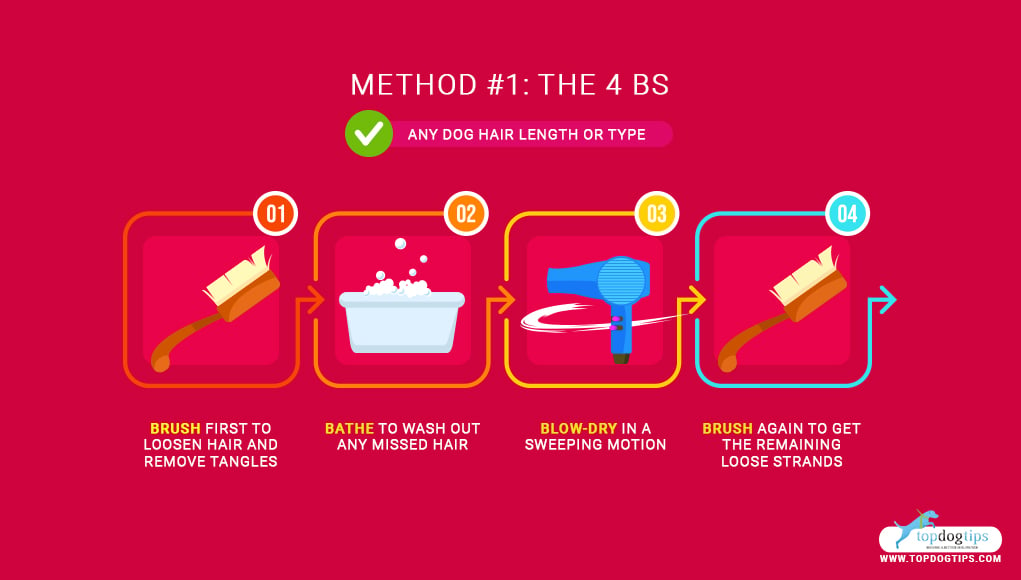
Method #1: The 4 Bs
Suitable for: Any dog hair length or type.
This is a quick and short-lived fix.
It will reduce dog hair for a day or two and keep your shedding dog feeling comfortable until you can really get to work on their coat.
Here’s the order of events:
- Brush first to loosen hair and remove tangles;
- Bathe to wash out any missed hair;
- Blow-dry in a sweeping motion;
- Brush again to get the remaining loose strands.
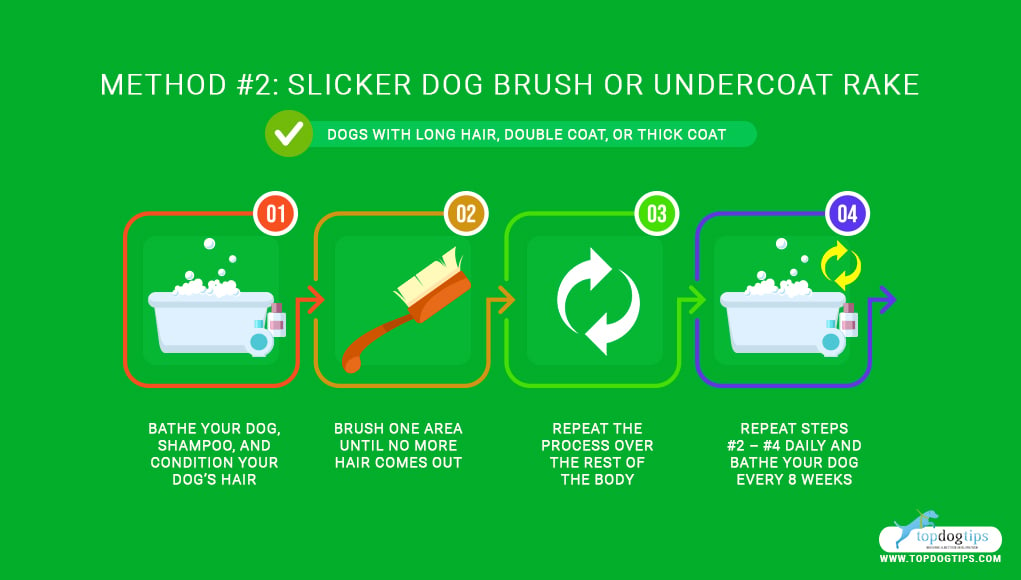
Method #2: Slicker Dog Brush or Undercoat Rake
Suitable for: Dogs with long hair, double coat, or thick coat.
A slicker dog brush (like Hertzko or Glendan) has fine metal bristles, while an undercoat dog rake has narrow teeth.
Both of these dog brushes are designed for removing the undercoat while leaving the topcoat untouched, which is one of the best methods for de-shedding a dog. The slicker dog brush is also useful for removing tangles.
In the meantime, here's how to use these brushes for de-shedding a dog:
- Bathe your dog, shampoo, and condition your dog’s hair*
- Brush one area until no more hair comes out
- Repeat the process over the rest of the body
- Repeat steps #2 – #4 daily and bathe your dog every 8 weeks.
- #1 SMALL ANIMALS, CAT & DOG...
- EFFECTIVE SLICKER BRUSH - This...
- PAWS-ITIVELY VERSATILE - This...
- EASY TO CLEAN LONG HAIR DOG...
- PAW-SOME SMART DESIGN -...
- Easy to Clean Pet Grooming...
- Pet Slicker Brush doing...
- Our Pet Brush is Simple design...
- Pet Massage Brush massage for...
- Glendan Dog Brush Warranty: 90...
Tip: If you’re short on time, use a coat spray or leave-in conditioner for dogs. Mist it onto your dog’s coat and brush it through.
This reduces static and softens the coat for easier hair removal, which you can follow with a smooth de-shedding session.
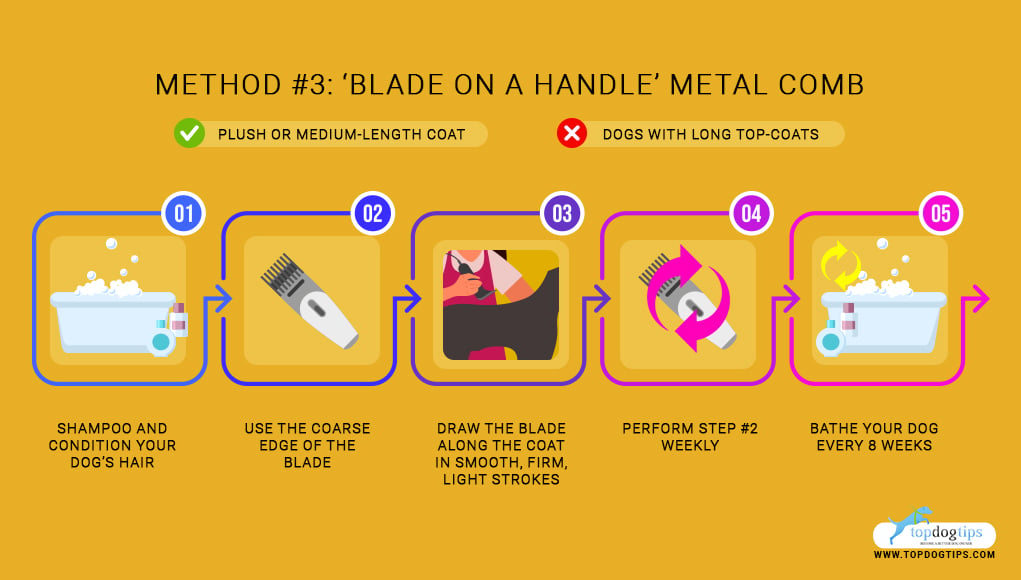
Method #3: ‘Blade on a Handle’ Metal Comb
Suitable for: Plush or medium-length coat.
Not suitable for: Dogs with long top-coats.
Deshedding tools with shedding blades (like the FURminator or DakPets) have very narrow teeth that seek out the fine, soft, fuzzy undercoat and leave the dog's overcoat alone.
These de-shedding combs do an exhaustive job, remove a ton of hair from dogs, but also make quite a mess with a pile of dog hair all over the place that you'll need to vacuum.
Usually, this job is best done outside or in the garage.
- Stainless steel deShedding...
- FURejector button releases...
- Ergonomic handle for comfort...
- Remove loose hair without...
- DeShedding tool for medium...
- EFFECTIVE: DakPets cat and dog...
- MULTIPLE BENEFITS: Our dog and...
- ROBUST: DakPets cat and dog...
- USER-FRIENDLY: This easy-grip...
- RECOMMENDED BY VETS: All...
Here's what you do with a pet de-shedding tool:
- Like before, shampoo and condition your dog’s hair (same pro tip applies);
- Use the coarse edge of the blade;
- Draw the blade along the coat in smooth, firm, light strokes;
- Perform step #2 weekly to clean and invigorate the coat and maintain its health;
- Bathe your dog every 8 weeks.
If you need help bathing your dog, we've got a full guide to walk you through the process.
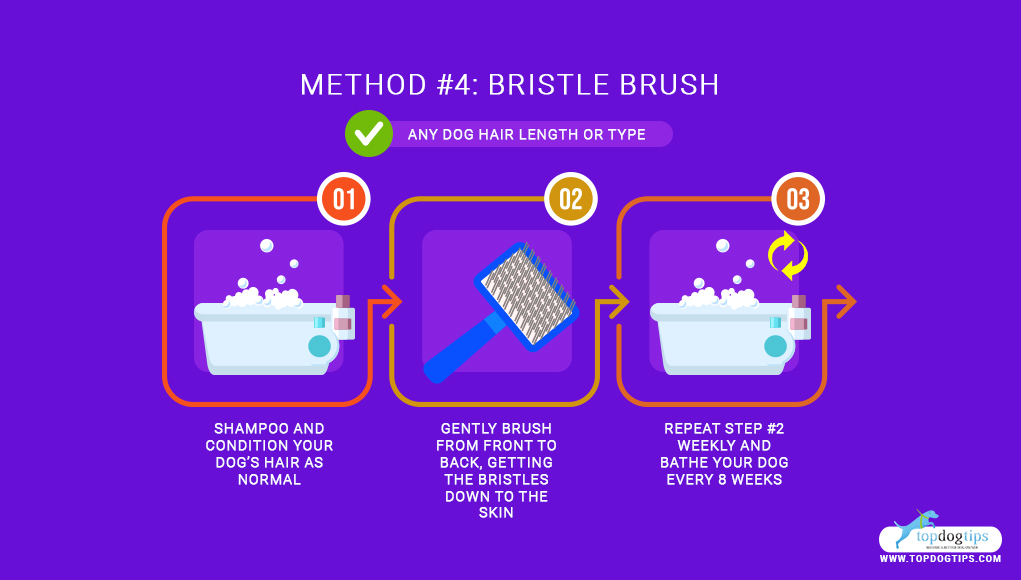
Method #4: Bristle Brush
Suitable for: Any hair length or type
The bristle dog brush (like Conair or Hertzko) is a general-purpose brush designed specifically for shedding dogs.
It won’t necessarily attack your dog's undercoat, but it will help to detangle and stimulate circulation there while also slightly de-shedding your canine. It's not the best solution, but it's one of them.
Alternatively, you can also explore things like grooming mitts that aren't specifically for shedding dogs, but they help a little, and also, dogs seem to enjoy them more.
- Ideal for everyday use, the...
- The CONAIR dog and cat hair...
- This everyday pet brush is as...
- Simply brush in the direction...
- CONAIRPROPET includes a wide...
- IDEAL BRUSH FOR EVERYDAY...
- GENTLE & SAFE - Densely packed...
- GROOMS AND MASSAGES FOR A...
- COMFORTABLE, STRONG, AND...
- HEALTHY COAT WITH NATURAL OIL...
Here's how to use a simple bristle doggy brush:
- Shampoo and condition your dog’s hair as normal (use the pro tip from above);
- Gently brush from front to back, getting the bristles down to the skin;
- Repeat step #2 weekly and bathe your dog every 8 weeks.
As you can see, the overall process is fairly similar to those mentioned above.
The only difference is the tool you use and how much dog hair you'll be able to get out of your pet, depending on their coat type.
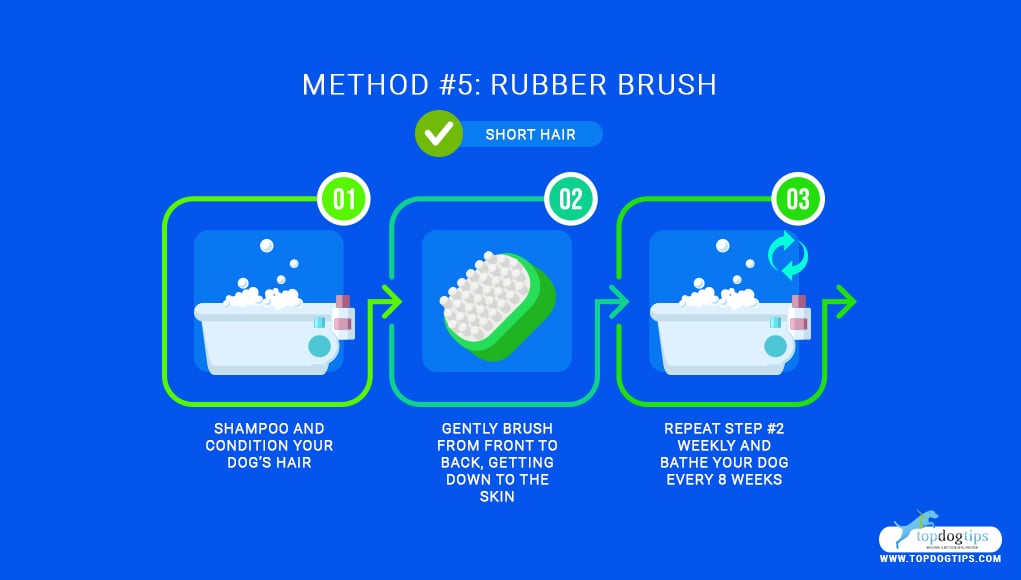
Method #5: Rubber Brush
Suitable for: Short hair
When de-shedding a dog, rubber brushes (like FurBliss) remove loose hair and dirt while also stimulating circulation. Again, a rubber dog brush is very similar to those bristle brushes and grooming mitts in terms of how much hair you'll be able to remove from your dog.
These rubber brushes aren't specifically for shedding dogs, so consider getting those as alternatives or to groom your dog in between your de-shedding sessions to minimize the amount of hair and stimulate circulation in his skin.
- 2-SIDED MULTIFUNCTION PET...
- LONG LASTING MATERIAL...
- PET HAIR REMOVER &...
- USE WET OR DRY - The Furbliss...
- VET-FOUNDED, VET-FORMULATED,...
To use it, follow the same routine as before:
- Shampoo and condition your dog’s hair;
- Gently brush from front to back, getting down to the skin;
- Repeat step #2 weekly and bathe your dog every 8 weeks.
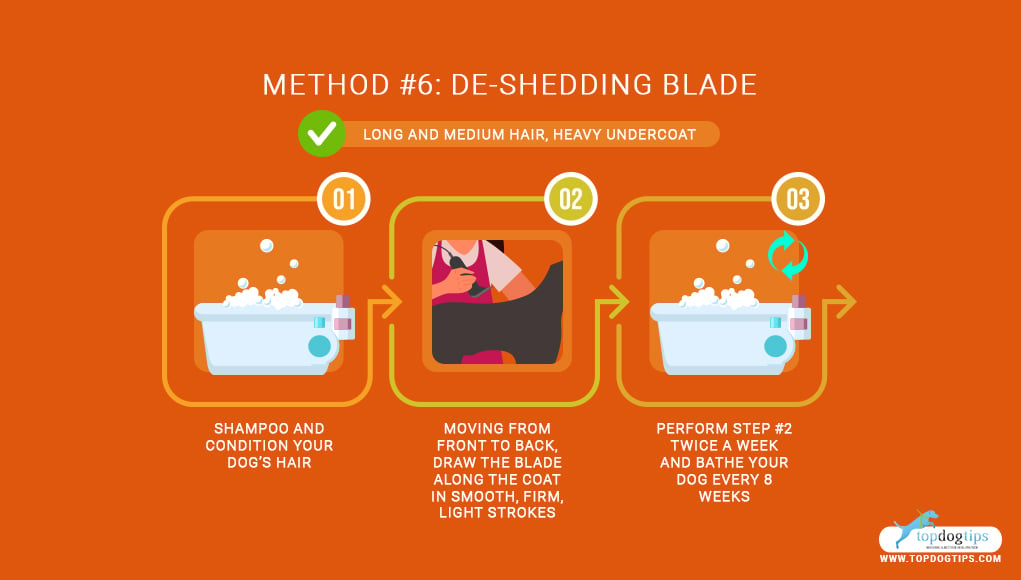
Method #6: De-shedding Blade
Suitable for: Long and medium hair, heavy undercoat
Deshedding blades (like Safari or SleekEZ) are a type of metal comb, and it isn’t half as scary as it looks or sounds.
There’s very little damage you can do to yourself or your dog with this tool – all you need to do is first try it out.
The only issue with a de-shedding blade for dogs is that it can sometimes pull on matted hair and tangles, so it's advisable to bathe your dog, use a conditioner, and have a slicker brush on hand to tackle those detangling missions.
Using a blade while de-shedding a dog is another method that removes a lot of hair – similar to those de-shedding tools with blades I mentioned above – so I recommend completing this job outside or in the garage if you can. It's messy.
- Dog Shedding Blade: Ridged...
- Versatile Dog Shedding Brush:...
- Dog Brush for Shedding: Hold...
- Blade for Dog Grooming Kit:...
- Coastal Pet Cares: We design...
- [WORLD’S #1 PATENTED...
- [PAINLESS & ENJOYABLE FOR YOUR...
- [EASY TO CLEAN & ERGONOMIC...
- [WIDE APPLICATION & USA MADE]...
- [TAKE GOOD CARE!] - Many...
Again, using this tool is very similar:
- Shampoo and condition your dog’s hair (remember the pro tip from above);
- Moving from front to back, draw the blade along the coat in smooth, firm, light strokes;
- Perform step #2 twice a week and bathe your dog every 8 weeks.
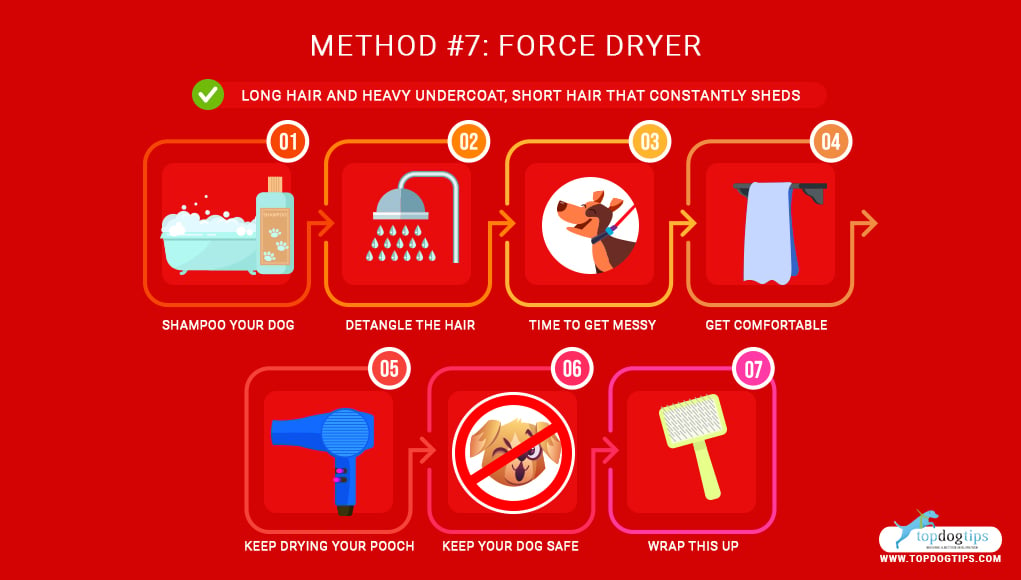
Method #7: Force Dryer
Suitable for: Long hair and heavy undercoat, short hair that constantly sheds.
A force pet dryer (like Shelandy or Flying Pig) is a high-powered blow dryer.
It breaks up clumps of the dog's matted hair as well as drying the hair and blowing out the loose undercoat.
This is the ultimate tool in de-shedding a dog, and it’s the professional groomer’s secret weapon. Of course, it's also the most expensive solution.
Costing anywhere from $70 and up to $400, it’s not a cheap piece of kit, but it will easily pay for itself in a few months if you’ve been using a professional groomer for de-shedding a dog.
This-shedding vacuum/dryer produces unbelievable results, too. There are many other – some better, some cheaper – dog dryers available as well.
Force drying is a very messy business, however. This is why most professional dog groomers use it, or people who can afford to have an in-home grooming station at their house with a grooming table.
When using a pet force dryer, it’s advisable to wear goggles, a mask, and overalls. You will get covered in hair.
You can also do this job in the garage, or if it’s a fine day, in your backyard.
- ①Output power: 2400W...
- ②Airflow variable:...
- ③New tech for noise...
- ④Flexible hose can be...
- ⑤One-year Warranty, Simple...
- Constructed with steel shell...
- Equipped 10 ft. flexible...
- Air Volume: 240 CFM/Air Speed:...
- Heats: None, Low, High...
- Powerful motor/12.72...
Here's the whole process of using a force dryer for de-shedding a dog:
- Shampoo your dog. Use plenty of soap and clean all the way down to the skin. Wash well, and rinse thoroughly.
- Detangle the hair. Work in tons of crème rinse or conditioner for dogs. This is what releases the undercoat in the end process. Work it through the entire coat, all the way down to the skin. Rinse very thoroughly to avoid skin irritation.
- Time to get messy. Attach a lead to your dog’s collar and hold him still, keeping him relaxed and calm.
- Get comfortable. Drying a dog with a force dryer will take at least half an hour. Turn the dryer on to full power and blow out all the undercoats. Hold the nozzle close to the skin and use a short back and forth motion. You can also combine it with drying your dog using a towel – there are specific dog drying towels that absorb a lot of water.
- Stay the course. Keep drying your pooch until the dog is COMPLETELY dry. Sometimes the undercoat won’t let go until it is bone dry. However, make sure that your pet is comfortable and safe. Please don't overdo it either.
- Keep your dog safe. Speaking of safety, take care not to blow dry your dog’s eyes and ears. You can tackle the head area with a dog brush.
- Wrap this up. Finish the job off with a slicker dog brush, brushing thoroughly all over to remove the last of the loose undercoat. And then you're done!
Other Ways to Manage Your Dog’s Shedding
While the above methods let you de-shed your dog, you can also take other actions to help manage the shedding. The idea is that with a few simple actions, you can reduce the amount of shedding your dog does and the amount of de-shedding you need to do.
- Follow a healthy diet: Make sure your dog gets proper nutrition to promote strength and resilience in his hair follicles. It will also help hydrate his skin, as dehydrated skin can make hair loss and shed worse.
- Bathe him regularly: Bathing is a key step in many of the above methods, and for a good reason. Bathing helps get rid of excess hair and dead hair before it can even shed. You can even use a de-shedding shampoo.
- Trim his fur short: Depending on your breed, you may want just to cut your dog’s fur short. This will reduce the amount that he can shed.
- Give him enough water: We mentioned that dehydrated skin is more prone to shedding and hair loss. You can easily combat this by making sure your dog has access to fresh water at all times.
- Talk to the vet: If you’ve tried the various methods on this list and your dog is still shedding too much, take him to the vet. There may be a medical condition that causes his excess shedding.
- A bonus for you: If your dog’s excessive shedding is irritating you or causing an allergy flare-up, consider getting an air purifier.
Common Questions About Ways of Deshedding a Dog
Have some lingering questions about de-shedding your dog or preventing the shedding in the first place? We have the answers here.
What is the best way to de-shed a dog?
Any of the methods on our list above are great options for de-shedding your dog. When in doubt, stick to the four Bs: brush, bathe, blow-dry, and brush.
Is it better to de-shed a dog wet or dry?
It would be best if you typically brushed your dog’s coat when it is dry. If the coat is wet, you will notice that the fur is harder to remove. This means that if you bathe your dog and want to brush his fur, you should dry it first.
What home remedy can I give my dog for shedding?
Start by making sure your dog is eating a healthy diet and drinking enough water. You can also try a de-shedding shampoo or a shampoo that includes oatmeal.
Why do dogs lick you?
Dogs can lick people for a range of reasons. It is one of the ways that they say hi or show that they love us. They may also have ulterior motives and lick you if you have something on your skin, especially food.
How do I get the undercoat off my dog?
If your dog has an undercoat, the best way to de-shed it is to rake it. You will need to start by de-matting your dog and then use a shedding tool. From there, you can use an undercoat rake. Finish up by bathing your dog and drying him off.
READ NEXT: How to Stop Dogs from Shedding
Disclosure: We may earn affiliate commissions at no cost to you from the links on this page. This did not affect our assessment of products. Read more here and find full disclosure here.


